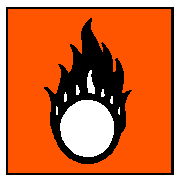International Chemical Safety Cards
| CHROMYL CHLORIDE | ICSC: 0854 |
| CHROMYL CHLORIDE Chromic oxychloride Dichlorodioxochromium Chromium dichloride dioxide CrO2Cl2 Molecular mass: 154.9 CAS # 14977-61-8 RTECS # GB5775000 ICSC # 0854 UN # 1758 EC # 024-005-00-2 |
 |
 |
| TYPES OF HAZARD/ EXPOSURE |
ACUTE HAZARDS/ SYMPTOMS |
PREVENTION | FIRST AID/ FIRE FIGHTING |
| FIRE | Not combustible but
enhances combustion of other substances. Many reactions may cause fire or explosion. |
NO contact with flammable
substances. |
Carbon dioxide. Special
powder. NO hydrous agents. NO water. In case of fire in the surroundings: use no water
unless protected against toxic gases. |
| EXPLOSION | |
|
In case of fire: keep
drums, etc., cool by spraying with water but NO direct contact with water. |
| EXPOSURE | |
AVOID ALL CONTACT! |
IN ALL CASES CONSULT A
DOCTOR! |
| INHALATION | Cough. Laboured breathing.
Shortness of breath. Sore throat. |
Ventilation, local exhaust,
or breathing protection. |
Fresh air, rest.
Half-upright position. Artificial respiration if indicated. Refer for medical attention. |
| SKIN | Redness. Skin burns. Pain.
Blisters. |
Protective gloves.
Protective clothing. |
Remove contaminated
clothes. Rinse skin with plenty of water or shower. Refer for medical attention. |
| EYES | Redness. Pain. Severe deep
burns. |
Face shield, or eye
protection in combination with breathing protection. |
First rinse with plenty of
water for several minutes (remove contact lenses if easily possible), then take to a
doctor. |
| INGESTION | Abdominal pain (further see
Inhalation). |
Do not eat, drink, or smoke
during work. |
Rinse mouth. Do NOT induce
vomiting. Refer for medical attention. |
| SPILLAGE DISPOSAL | STORAGE | PACKAGING & LABELLING | ||
| Evacuate danger area!
Ventilation. Collect leaking liquid in sealable containers. Absorb remaining liquid in
sand or inert absorbent and remove to safe place. Do NOT wash away into sewer. Do NOT
absorb in saw-dust or other combustible absorbents. NEVER direct water jet on liquid
(extra personal protection: complete protective clothing including self-contained
breathing apparatus). |
Fireproof. Separated from
combustible and reducing substances, food and feedstuffs. Cool. Dry. Keep in the dark.
Keep in a well-ventilated room. |
Airtight. Do not transport
with food and feedstuffs. O symbol C symbol R: 8-35 S: 7/8-22-28 UN Hazard Class: 8 UN Packing Group: I |
||
| SEE IMPORTANT INFORMATION ON BACK | ||||
|
||||